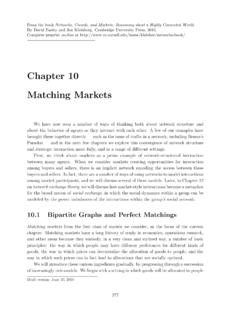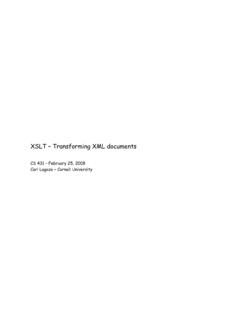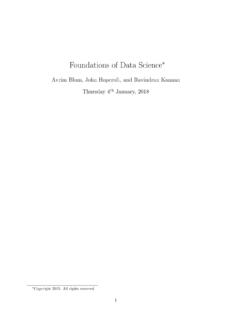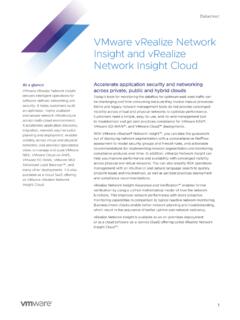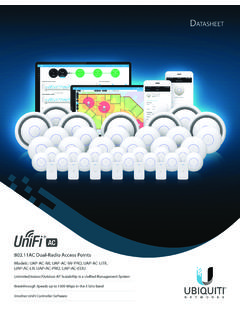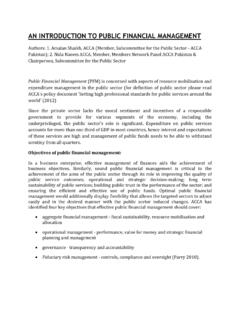Transcription of Chapter 8 Modeling Network Traffic using Game Theory
1 Chapter 8 Modeling Network Traffic using GameTheoryFrom the bookNetworks, Crowds, and Markets: Reasoning about a Highly Connected David Easley and Jon Kleinberg. Cambridge University Press, preprint on-line at the initial examples in our discussion of game Theory in Chapter 6, we notedthat traveling through a transportation Network , or sending packets through the Internet,involves fundamentally game-theoretic reasoning: rather than simply choosing a route inisolation, individuals need to evaluate routes in the presence of the congestion resulting fromthe decisions made by themselves and everyone else. In this Chapter , we develop models fornetwork traffic using the game-theoretic ideas we ve developed thus far.
2 In the process ofdoing this, we will discover a rather unexpected result known asBraess s Paradox[76] which shows that adding capacity to a Network can sometimes actually slow down Traffic at EquilibriumLet s begin by developing a model of a transportation Network and how it responds to trafficcongestion; with this in place, we can then introduce the game-theoretic aspects of represent a transportation Network by a directed graph: we consider the edges to behighways, and the nodes to be exits where you can get on or offa particular highway. Thereare two particular nodes, which we ll callAandB, and we ll assume everyone wants to drivefromAtoB.
3 For example, we can imagine thatAis an exit in the suburbs,Bis an exitdowntown, and we re looking at a large collection of morning commuters. Finally, each edgehas a designated travel time that depends on the amount of traffic it make this concrete, consider the graph in Figure The label on each edge gives theDraft version: June 10, 2010229230 Chapter 8. Modeling Network TRAFFIC using GAME THEORYBACDx/1004545x/100 Figure : A highway Network , with each edge labeled by its travel time (in minutes) whenthere arexcars using it. When 4000 cars need to get fromAtoB, they divide evenly overthe two routes at equilibrium, and the travel time is 65 time (in minutes) when there arexcars using the edge.
4 In this simplified example,theA-DandC-Bedges are insensitive to congestion: each takes 45 minutes to traverseregardless of the number of cars traveling on them. On the other hand, theA-CandD-Bedges are highly sensitive to congestion: for each one, it takesx/100 minutes to traversewhen there arexcars using the , suppose that 4000 cars want to get fromAtoBas part of the morning are two possible routes that each car can choose: the upper route throughC, or thelower route throughD. For example, if each car takes the upper route (throughC), thenthe total travel time for everyone is 85 minutes, since 4000/100 + 45 = 85. The same is trueif everyone takes the lower route.
5 On the other hand, if the cars divide up evenly betweenthe two routes, so that each carries 2000 cars, then the total travel time for people on bothroutes is 2000/100 + 45 = what do we expect will happen? The traffic model we ve describedis really a game in which the players correspond to the drivers, and each player s possiblestrategies consist of the possible routes fromAtoB. In our example, this means that eachplayer only has two strategies; but in larger networks, there could be many strategies foreach player. The payofffor a player is the negative of his or her travel time (we use thenegative since large travel times are bad).
6 1 The travel times here are simplified to make the reasoning clearer: in any real application, each roadwould have both some minimum travel time, and some sensitivity to the number of carsxthat are using , the analysis here adapts directly to more intricate functions specifying the travel times on BRAESS S PARADOX231 This all fits very naturally into the framework we ve been using . One thing to notice,of course, is that up to now we have focused primarily on games with two players, whereasthe current game will generally have an enormous number of players (4000 in our example).But this poses no direct problem for applying any of the ideas we ve developed.
7 A game canhave any number of players, each of whom can have any number of available strategies, andthe payoffto each player depends on the strategies chosen by all. A Nash equilibrium is stilla list of strategies, one for each player, so that each player s strategy is a best response toall the others. The notions of dominant strategies, mixed strategies and Nash equilibriumwith mixed strategies all have direct parallels with their definitions for two-player this traffic game, there is generally not a dominant strategy; for example, in Figure route has the potential to be the best choice for a player if all the other players areusing the other route.
8 The game does have Nash equilibria, however: as we will see next,any list of strategies in which the drivers balance themselves evenly between the two routes(2000 on each) is a Nash equilibrium, and these are the only Nash does equal balance yield a Nash equilibrium, and why do all Nash equilibria haveequal balance? To answer the first question, we just observe that with an even balancebetween the two routes, no driver has an incentive to switch over to the other route. For thesecond question, consider a list of strategies in whichxdrivers use the upper route and theremaining 4000 xdrivers use the lower route. Then ifxis not equal to 2000, the two routeswill have unequal travel times, and any driver on the slower route would have an incentive toswitch to the faster one.
9 Hence any list of strategies in whichxis not equal to 2000 cannotbe a Nash equilibrium; and any list of strategies in whichx= 2000 is a Nash Braess s ParadoxIn Figure , everything works out very cleanly: self-interested behavior by all drivers causesthem at equilibrium to balance perfectly between the available routes. But with only asmall change to the Network , we can quickly find ourselves in truly counterintuitive change is as follows: suppose that the city government decides to build a new, veryfast highway fromCtoD, as indicated in Figure To keep things simple, we ll model itstravel time as 0, regardless of the number of cars on it, although the resulting effect wouldhappen even with more realistic (but small) travel times.
10 It would stand to reason thatpeople s travel time fromAtoBought to get better after this edge fromCtoDis it?Here s the surprise: there is a unique Nash equilibrium in this new highway Network ,but it leads to a worse travel time for everyone. At equilibrium, every driver uses theroute through bothCandD; and as a result, the travel time for every driver is 80 (since4000/100 + 0 + 4000/100 = 80). To see why this is an equilibrium, note that no driver can232 Chapter 8. Modeling Network TRAFFIC using GAME THEORYBACDx/1004545x/1000 Figure : The highway Network from the previous figure, after a very fast edge has beenadded fromCtoD.

